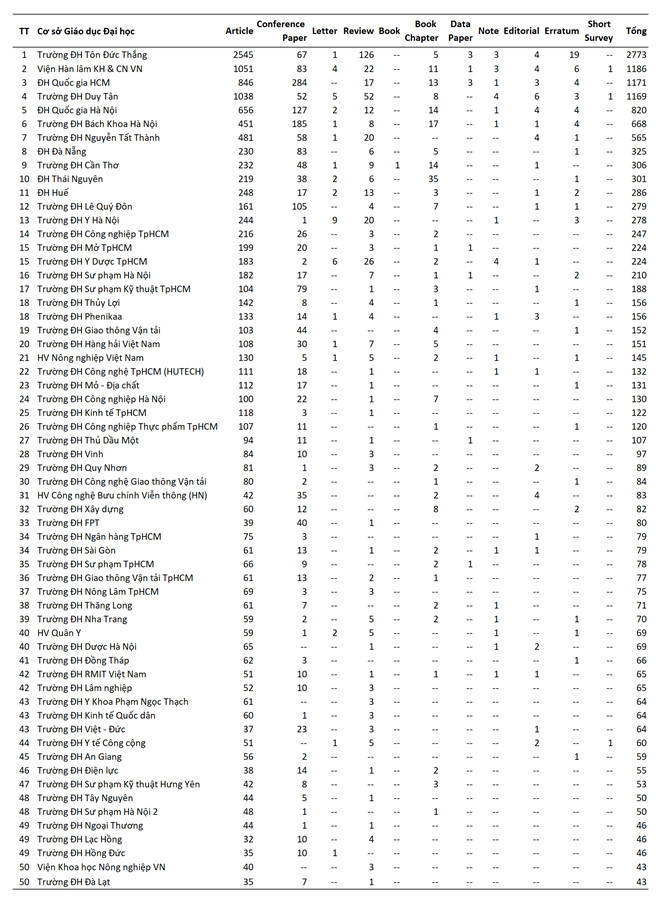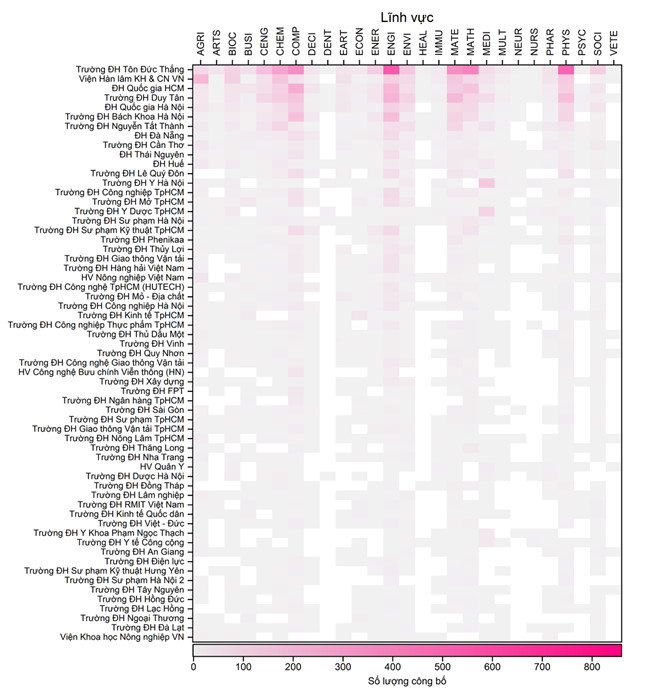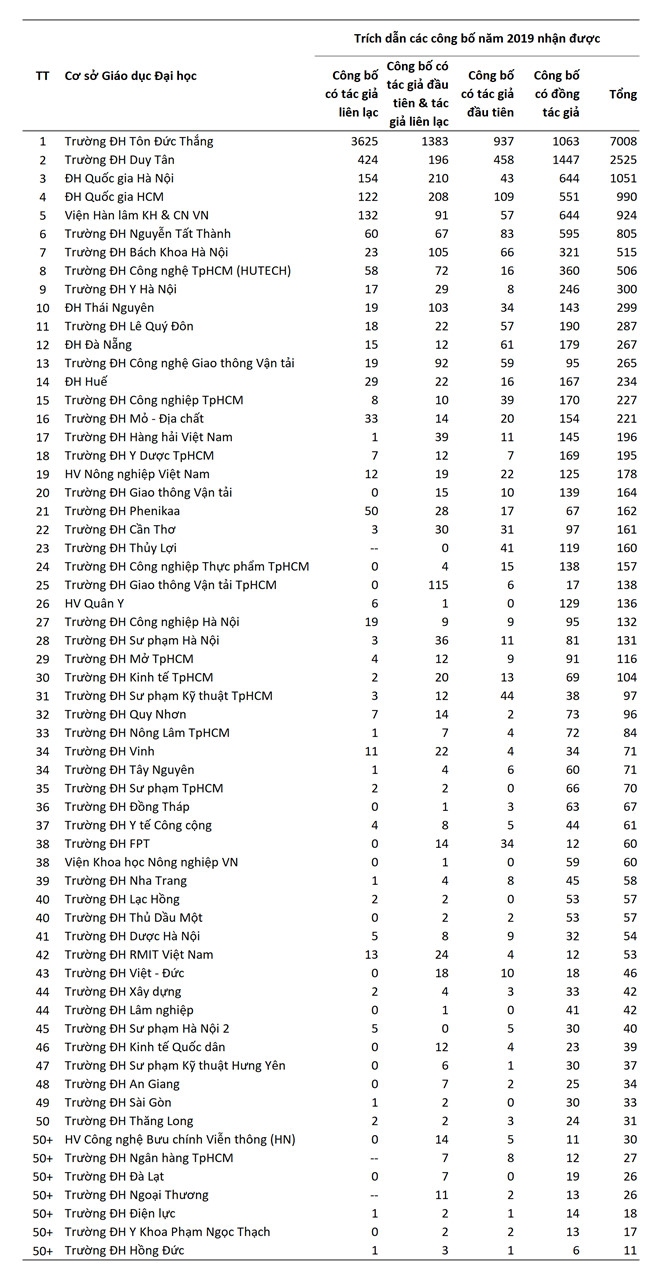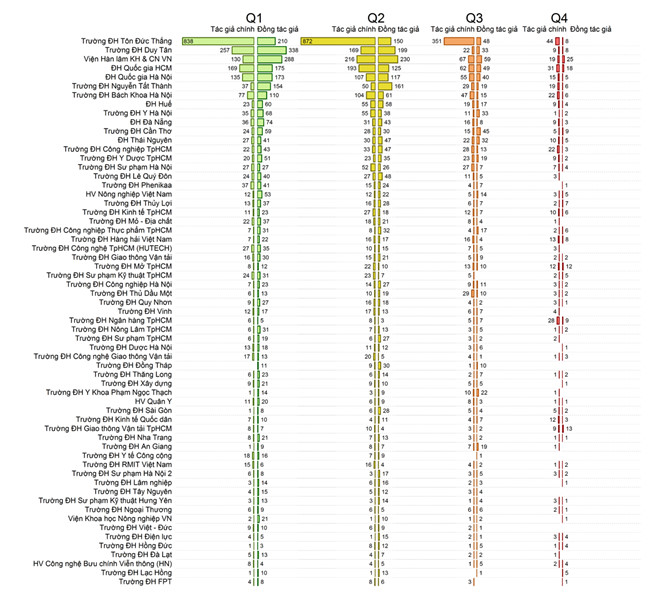Top 50 best higher educational institutions with international publications in Vietnam 2019
In 2019, the total number of publications from Vietnam reached 12,307 of several types. In particular, the number of publications owned by Vietnamese higher educations accounted for 90.3%, corresponding to 11,118 publications. The rest came from hospitals, independent research institutions, companies, colleges, and a handful of high schools.
Productivity analysis

The top 50 higher educational institutions with the highest publication productivity in 2019 are named in Table 1. With the rate of “exponential” growth in recent years, Ton Duc Thang University (TDTU) has continued to surpass Vietnam Academy of Science and Technology to own the most published papers in Vietnam. TDTU’s number of publications in all types is 2.3 times as high as the three following institutions listed below.
The data also indicates that there are 4 higher educational institutions with the productivity of more than 1,000 publications per year, including:
- Ton Duc Thang University
- Vietnam Academy of Science and Technology,
- Vietnam National University, Ho Chi Minh City
- Duy Tan University.
The top 10 higher educational institutions with the highest publication productivity across the country in 2019 are as follows:
• 7 public universities: Ton Duc Thang University, Vietnam National University Ho Chi Minh City, Vietnam National University Hanoi, Hanoi University of Science and Technology, University of Da Nang, Can Tho University, and Thai Nguyen University;
• 1 major research institute: Vietnam Academy of Science and Technology;
• 2 private universities: Duy Tan University and Nguyen Tat Thanh University.

An analysis of the international publication distribution (Figure 1) indicates that the majority of higher education institutions focus their research in the following fields (in alphabetical order): Agriculture and Biology - AGRI; Biochemistry, Genetics, Molecular Biology - BIOC; Chemical Engineering - CENG; Chemistry - CHEM; Computer Science - COMP; Earth and Planetary Sciences - EART; Energy - ENER; Engineering - ENGI; Environmental Science - ENVI; Materials Science - MATE; Math - MATH; Medicine - MEDI; and Physics and Astronomy- PHYS. In particular, the most important areas of Vietnam's education and research institutions are:
- Engineering
- Physics and Astronomy
- Materials Science
- Math.
Some other fields have a limited number of publications, such as: Business, Administration and Accounting - BUSI, Decision Sciences - DECI, Economics, Econometrics and Finance - ECON, Multidisciplinary - MULT, Pharmacology, Toxicology and Pharmaceutics - PHAR, and Social Sciences - SOCI. Meanwhile, the other fields have been little researched, including Arts & Humanities - ARTS, Dentistry - DENT, Health Professions - HEAL, Immunology and Microbiology - IMMU, Neuroscience - NEUR, Nursing - NURS, Psychology - PSYC, and Veterinary - VETE.
Citation analysis
By the time the data was last updated, the total number of citations in all publications from Vietnam in 2019 had reached 16,211, 88.6% of which came from the aforementioned 50 higher education institutions, corresponding to 14,357 times. Please note that the sum of citations of these institutions is not an aggregation of the citation index of each one of them, but the total number of worldwide published articles citing at least one of them.

The data in Table 2 shows that the total citations from publications in 2019 from Ton Duc Thang University and Duy Tan University are higher than the other educational institutions. Regarding the role of the author in the works, it is easy to see a pattern emerging amongst the majority of educational institutions. This pattern is a trend towards the number of citations of co-authors being greater than that of lead authors. This excludes a few opposing institutions who carry huge differences, such as Ton Duc Thang University, University of Transport Technology, and Ho Chi Minh City University of Transport.
Publication-quality analysis
An indicator called Impact Factor (IF) is often used as a measure to evaluate the quality of a journal and is published by Clarivate's Science of Science database. However, the distribution of the IF index varies widely between different industries and fields. Therefore, it is difficult to use IF to evaluate the quality of journals in different fields, and it is not sufficient to evaluate the quality of publications amongst institutions, especially between interdisciplinary and monodisciplinary ones. Instead, the measure should be the ‘journal ranking’ in each separate field (quartile, or Q). This value is now also used by research funding agencies (such as the NAFOSTED) and universities to evaluate the relative quality of publications. Large scientific databases such as Web of Science and Scopus all have their own rankings for the journals they index. For example, on Web of Science, journals in the same field are ranked from high to low according to IF index, and are divided into 4 groups of journals with equal quantity. The top quarter of journals with the highest IF index is called Q1, the next is Q2, then Q3 and finally Q4. The Q ranking of Scopus journals is similar. This analysis uses the Q ranking from Scopus (Scimago Lab).
According to many experts with a wealth of international publishing experience, the possibility of refusing to publish articles in Q1 journals is quite high. This means that only high-quality research producing influential findings are likely to be published. Therefore, institutions that have many publications in Q1 or Q2 journals - especially those where the lecturers/teachers of the institutions’ own are the lead authors - can be seen to be robust in research.

Table 3 analyzes the number of articles (articles and articles in press) of the top 50 higher education institutions in the Q-rank of journals that publish those articles, taking account of the authors' role in the articles. The order of the institutions is sorted by the total number of articles given in Table 1.
Further analysis of the authors’ role in the articles shows that the proportion of co-authored articles is larger than the number of articles with the main author (the contact author, the first author, or both) in most higher education institutions, as well as in most journals ranked from Q1 to Q4. However, the difference is generally not too vast, except for some educational institutions such as Nguyen Tat Thanh University, Dong Thap University, Lac Hong University, or Vietnam Academy of Agricultural Sciences. These institutions are the exception, as they have several times as many co-authored articles as authored ones.
Particularly for Ton Duc Thang University, the statement above is no longer applicable since the number of articles authored by its lecturers is multifold compared to the co-authored ones across all groups from Q1-Q4. It is, in fact, a "miracle" in the picture of scientific research in Vietnam today.
From: TDTU
- Log in to post comments








